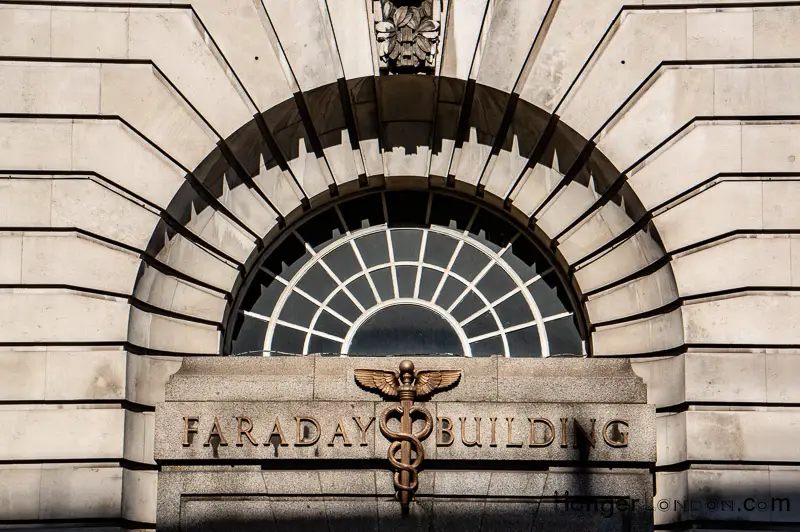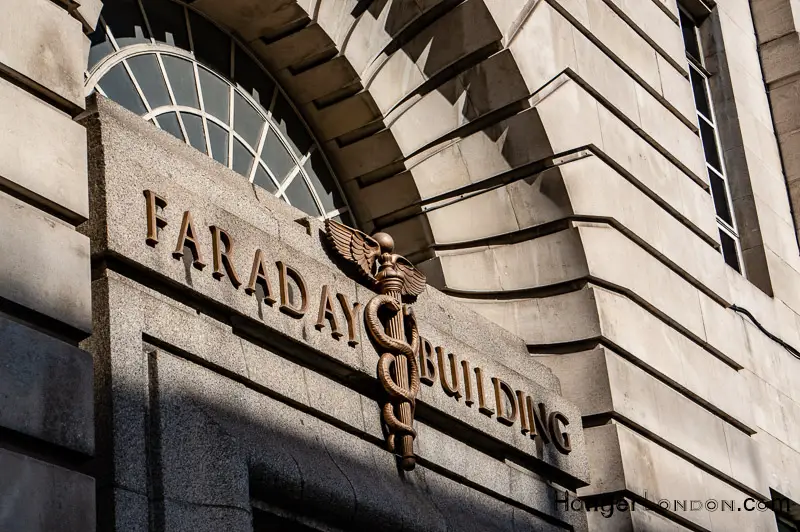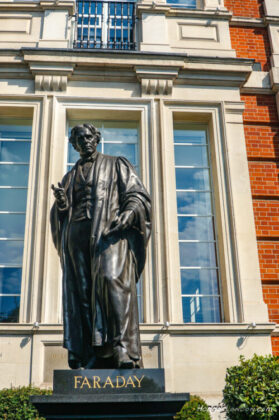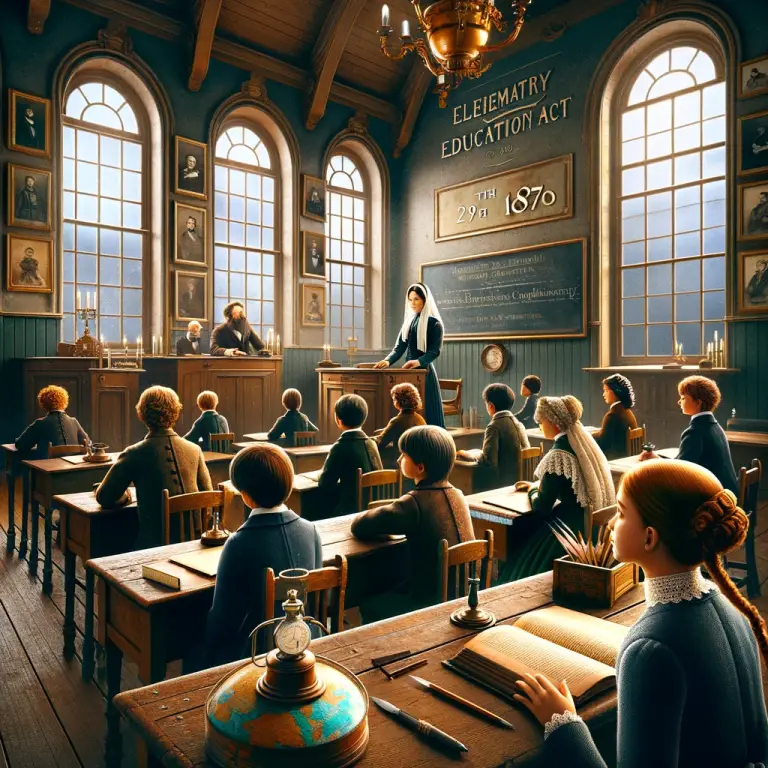The Michael Faraday Statue in London
The Faraday Statue above stands outside 2 Savoy Place WC2. It stands in front of the now Institution of Engineering & Technology. Back in the past, it was known as the Institute of Electrical Engineers founded in 1871 and moved to this site around 1910. There is an original Marble statue of this that was made in 1874 this stands at the Royal Institute.
Michael Faraday on the back of the £20 note
Michael Faraday was pictured on the back of the 20 pound note which went into circulation in 1991. This note was withdrawn from circulation 10 years later in 2001.
Who is Michael Faraday? One of Great Britains Scientific heroes?
In 1831, Faraday was most noted for being the person to publish the discovery of Electromagnetic induction. This involves mechanical movement, energy from a person, water power, or machinery, which could be turned into the steady electric current. This was not all he contributed to science.
Up until that point, other scientists had wondered if Electricity was flowing down a wire. Also, that electricity produced a magnetic field. Faraday wondered what if magnetism could produce electricity? What if electricity flowed through other means, by creating tension in a substance. What we now know as a conductor. There is a bit of time to travel through before things got to that stage in 1831.
Faraday continued research and experiments with electricity. He was often criticized for not mentioning other contributors to some of his published works. Even his own Mentor, Professor Sir Humphry Davy. Who he forgot to mention on more than one occasion. He made a few people angry by doing this.
The Scientists involved with electricity before Faraday, The Evolution of Electricity
Alessandro Volta
Discovered he could produce a steady electric current in 1800. Volta’s Pile” a type of early battery,
Hans Christian Oersted
1820 Electric current is passed through a wire produced a magnetic field.
André- Marie Ampère
Many things electromagnetism, and eventually SI unit of measuring electricity which is why we use the word Amp
William Hyde Wollaston
For discovering friction could cause electricity and the beginnings of electromagnetic induction, some ten yrs before Faraday, who had picked up where Wollaston had left off, and published without referencing Wollaston. Also, Wollaston invented a method to raise the zinc plates out of battery acid so they would last longer.
Was Faraday from London?
The Early years of Michael Faraday
Faraday was born in Surrey, not London, some might think, back then the boundaries were different. He had actually come from the area of what is now known as Southwark. His family was on the breadline in a small living space.
48 Blandford Street, near baker street, was a bookbinder that Faraday had one of his first jobs. His education had been basic. But his Sandemanian Faith slightly less common, his religious education on Sunday as part of that faith also taught him things.
The Bookbinder took Faraday on as an apprentice which lasted 7 years. This is where he could read a lot of books.
It was whilst reading an article about electricity in Encyclopaedia Britannica about “Volta’s Pile” that sparked his passion for science. Faraday set about creating experiments. He also liked the book “Conversations on Chemistry” by Jane Marcet.
Scientific lectures in the city had a fee. Faraday’s brother helped fund this, so off Faraday went to City Philosophical Society lectures.
Michael Faraday in his 20’s
Around 1812 towards the end of Faraday’s Apprenticeship a customer of the bookbinder had given him a ticket to attend an important lecture at the Royal Institution. One of the leading professors of the institute, doing research in scientific studies, was giving the lecture. Hearing the Professor, Sir Humphry Davy talk, captivated Faraday. His note-taking needless to say became not only a bound book, but he had added his own artwork to it. Despite being ready to work as a fully trained bookbinder this trade bored Faraday who was more interested in Science.
Sir Joseph Banks President of the Royal Society who ran the most esteemed Scientific society, received a job application from Faraday. It was turned down, Faraday was not from the gentry and an unknown.
By the end of 1812 Faraday bit the bullet and sent the notebook that he has compiled to Davy himself, together with a letter asking for any job position that might be available. Davy was impressed but had no jobs at that point.
During 1813 a few events occurred which was to prove advantageous to Faraday, injury from an experiment, and a falling out with an assistant, this meant there was now a vacancy, and he thought of Faraday. Davy travelled to other countries to visit other scientists and Faraday came with him. Eventually, Farady was made into a full scientific laboratory assistant at the Royal Institution
Royal Institution Albemarle St London
What work was Michael Faraday involved with at the beginning of his career?
1815-16 Davy’s Miners Safety Lamp (Faraday work)
The standard way to carry light at the time, down the mines, was to use naked flames since electricity had not really been invented to produce light. Mines were dangerous full of methane gas, which lead to explosions.
So this lamp he worked on with Davy had a metal gauze that surrounded the wick but which did not ignite the gas.
1820 Chorine Gas, Carbon, Wedgewood potteries Clay Analyst (Faraday work)
Produced the first known compounds Chlorine and carbon.
Wedgewood potteries employed Faraday to analyse their clays.
1820’s Faraday and Joseph Henry invented the Dynamo
Michael Faraday in his 30’s
A “Pest and plague”, is how Faraday described Love. He had no time for relationships with women let alone marriage. This mindset did not last long, 1821 he was married to a Sandemanian woman, Sarah Barnard. He called his wife “Pillow of my mind”.
Faraday in 1824
Davy set up a new club for the gentry of the scientific and literary world & fine arts, called The Athenaeum. That still operates to this day. Guess who was asked to be the secretary? Faraday, he lasted a few months, it took up too much of his time.
Solid Liquid Gas
Faraday was interested and soon learned the relationship that substances could be converted or change from solids, liquids to gases. 1823, he succeeded in preparing Chlorine in liquid form. Also Liquefied Ammonia, gases, Carbon Dioxide being one example.
Faraday in 1825
Benzene was identified. Also, improvements about the glass used in telescopes took his interest.
Faraday in 1826
Faraday started the Christmas Lectures for children at the Royal Institute. A major hit, that took off for many more years in the future, and are still running to this day.
Faraday in 1831
Sir Charles Wheatstone, was doing a demo with powder moving and forming patterns on a metal plate that was vibrated by sound. Somehow this gave Faraday some bright spark idea about electricity again.
A ring of soft metal had two lengths of insulated wire wrapped around it, like a wreath in a coil. So it showed how magnetism could induce an electric current in a wire. A current passing through a coiled wire “A” magnetises the soft metal ring underneath it and induces a current in coiled wire B.
Faraday in 1832-33
Electrochemistry Faraday and William Whewell.
Faraday had been experimenting with what happens when you introduce electricity into liquids and chemicals. He devised what were the starting blocks of the rules of Electrochemistry. When electricity was sent through acidic water the object in the water attracted things to it.
Electrolysis is where electricity flows through a liquid or a solid this being the electrolyte. The current can pass from one electrode to another.
What is Electrodes?
A conductor that takes current into and out of an electrolyte.
Faraday enabled other scientists to take research and ideas further.
In 1836 Faraday was the scientific advisor of Trinity House. He started the research to enable electric lighting in Lighthouses. He worked with scientist Fredrick Holmes and by 1858 they enabled the first lighthouse in the world to be lit by electricity. That was at South Foreland Lighthouse now a National Trust treasure Dover.
Out of the different kinds of electricity that were known before 1839, Faraday was looking for the connections in all of them.
Summary of the different types of electricity that was known to Faraday at this time
Voltaic electricity –with a battery
Induced electricity- Electromotive force in a conductor like with the aid of magnetism
Static electricity –Friction that causes sparks or attracts dust hair
Natural animal electricity- Allesandro Volta studied the anatomy of the electric eel. There are other water electrical specimens, electric ray, electric catfish
So by the year, 1839 Faraday had surmised that electricity was not some invisible force, but that all materials had some kind of inductive ability. Some were electrical conductors, others non-conductors. So electricity was a force that reacted on particles within all matter.
The Faraday Building

136-144 Queen Victoria Street
Architect A.R. Myers
Two buildings one completed in 1890 and was a GPO post office building. It was converted into a telephone exchange in 1905.
The Faraday Building the taller building added at the start of the 1930s was completed in 1933. The same year the Telephone Exchange took residence there and became the worlds first international Telephone exchange. Above the arch of the building doorway where it says “Faraday Building”, you can see a sculpture of a face this is the God of Mercury and below the caduceus coiled snakes also symbolic of mercury the messenger /communication.

Other carvings in the stone above the windows show symbolic items associated, with telecommunications. For example, the objects portray a telephone, a reel of cables, an electromagnetic relay. A horseshoe magnet, to mark the significance of magnetism by which Faraday made important discoveries. A series of arrows forming wavy lines represent electrical pulses. There is also the Monogram of the then King George V.
Bylaws were created after this tall building was completed to stop other buildings from spoiling the View of St Pauls.
The final years of Faraday
After years of continuous work by 1839, the decline of Faraday’s health was beginning to show. For 6 years his creative energies stopped and it wasn’t until 1845 that he managed to pick up and continue with some of his previous research. Michael Faraday died on the 25th August 1867 at Hampton Court, a residence he had been given in recognition of his work in the scientific field. His name was given to the Farad, a unit of electrical capacitance (originally a Farad represented a unit of electrical charge.
Michael Faraday was born in London on 22nd September 1791 and died 25th August 1867 at the age of 75
Where was Faraday Born? the area is now part of Southwark
[mappress mapid=”56″]




